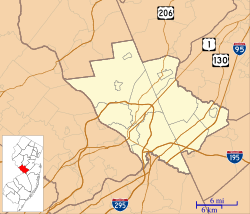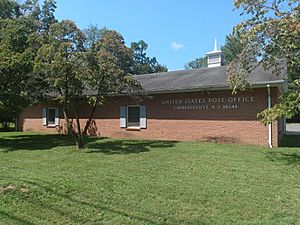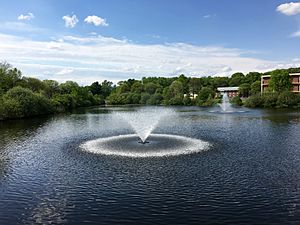Lawrenceville, New Jersey facts for kids
Lawrenceville is a community in Lawrence Township, located in Mercer County, New Jersey. It's known as a "census-designated place" (CDP), which means it's a specific area defined by the government for counting people. Lawrenceville is about halfway between the cities of Princeton and Trenton.
This community is part of the larger Trenton–Princeton metropolitan area. In 2020, about 3,751 people lived in Lawrenceville. The area is also called the "village of Lawrenceville." Its main historic area, called the Main Street Historic District, was recognized as a historic place in 1972. It was one of the first historic districts in New Jersey.
Quick facts for kids
Lawrenceville, New Jersey
|
|
|---|---|
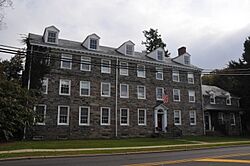
The Hamill House was built in 1814. It was the first building for The Lawrenceville School and is a national landmark.
|
|
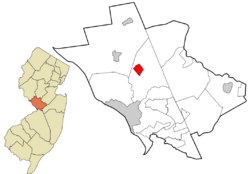
Location in Mercer County and the state of New Jersey
|
|
| Country | |
| State | |
| County | Mercer |
| Township | Lawrence |
| Named for | Maidenhead, England |
| Area | |
| • Total | 1.04 sq mi (2.70 km2) |
| • Land | 1.04 sq mi (2.70 km2) |
| • Water | 0.00 sq mi (0.00 km2) 0.09% |
| Elevation | 184 ft (56 m) |
| Population
(2020)
|
|
| • Total | 3,751 |
| • Density | 3,606.7/sq mi (1,392.6/km2) |
| Time zone | UTC−05:00 (Eastern (EST)) |
| • Summer (DST) | UTC−04:00 (Eastern (EDT)) |
| ZIP Code |
08648
|
| Area code(s) | 609 |
| FIPS code | 34-39570 |
| GNIS feature ID | 02390044 |
Contents
History of Lawrenceville
Lawrenceville was first settled in 1697 and was called Maidenhead. It was part of Burlington County in the colony of West Jersey. Later, in 1714, it became part of Hunterdon County. In 1798, the area officially became the Township of Maidenhead.
Why the Name Changed
The village was named after a town in England called Maidenhead. The name "Maidenhead" comes from an old Anglo-Saxon word meaning "new wharf."
In the early 1800s, a local pastor named Rev. Issac V. Brown, who also started the Academy of Maidenhead (now The Lawrenceville School), asked the government to change the town's name. He felt the name "Maidenhead" might sound a bit strange or old-fashioned to some people.
So, on January 24, 1816, the name was officially changed from Maidenhead to Lawrence. The township was named after Captain James Lawrence, a brave naval hero from the War of 1812. The village itself was renamed Lawrenceville at the same time. In 1838, Lawrence Township became part of the new Mercer County.
Lawrenceville During the Revolutionary War
During the American Revolutionary War, important events happened near Lawrenceville. After the Battle of Trenton and the Battle of the Assunpink Creek in late 1776 and early 1777, George Washington's troops marched through Maidenhead. They were chasing British soldiers.
The two sides met in the Battle of Princeton on January 3, 1777, which was just outside the township. Today, you can visit the Princeton Battlefield State Park there. A British general named Cornwallis even stayed overnight in Maidenhead in December 1776.
The Presbyterian Church of Lawrenceville, built in 1698, was originally called the Meetinghouse of Maidenhead. It is still an active church today.
Geography of Lawrenceville
Lawrenceville is located in the middle of Mercer County. It is northeast of Trenton and southwest of Princeton. The main road, U.S. Route 206, goes through the center of Lawrenceville and is called "Main Street." The historic part of the town is along Main Street.
The Lawrenceville School is also considered part of the village. The oldest buildings on its campus, known as "the Circle," are a National Historic Landmark.
Understanding Lawrenceville's Boundaries
The area officially known as the Lawrenceville census-designated place (CDP) has specific borders. These borders help define where the population statistics are counted.
Sometimes, people get Lawrenceville confused with Lawrence Township. This is partly because the local post office is in Lawrenceville, and for a long time, people in the entire township used "Lawrenceville" as their mailing address. In 2007, the U.S. Postal Service changed the preferred mailing address for the 08648 ZIP code to "Lawrence Township" to help clear up this confusion.
Lawrenceville is about the same distance from Trenton and Princeton. It is also closer to Philadelphia than to New York City. Important roads like U.S. Route 206 and U.S. Route 1 pass through or near Lawrenceville.
The Lawrenceville CDP covers about 1.04 square miles (2.70 square kilometers) of land. Most of this area is land, with only a tiny amount of water.
Population and People
| Historical population | |||
|---|---|---|---|
| Census | Pop. | %± | |
| 1990 | 6,446 | — | |
| 2000 | 4,081 | * | −36.7% |
| 2010 | 3,887 | −4.8% | |
| 2020 | 3,751 | −3.5% | |
| Population sources: 1990-2010 2000 2010 2020 * = Lost territory during previous decade. |
|||
Population in 2010
In 2010, there were 3,887 people living in Lawrenceville. There were 1,734 households, and 1,046 of these were families.
Most of the people (about 85%) were White. About 4% were Black or African American, and about 8% were Asian. A small number of people (less than 1%) were Native American or Pacific Islander. About 2% of people identified with two or more races. People of Hispanic or Latino background made up about 4% of the population.
About 27% of households had children under 18. The average household had 2.24 people, and the average family had 2.90 people.
Looking at age groups, about 21% of the population was under 18. About 12% were 65 years old or older. The average age in Lawrenceville was 43.2 years.
Education in Lawrenceville
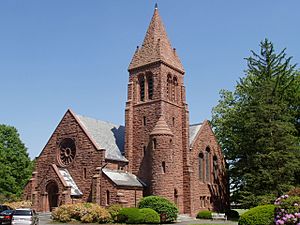
The public schools in Lawrenceville are part of the Lawrence Township Public Schools district. Lawrenceville Elementary School, one of the district's elementary schools, is located right in the community.
Lawrenceville is also home to The Lawrenceville School. This is a private boarding and day high school that was founded in 1810. It is one of the oldest and most respected prep schools in the United States.
Businesses and Economy
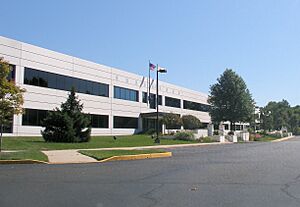
Historically, The Lawrenceville School was the biggest part of the economy in the village. After World War II, Lawrenceville became a "commuter town." This means many people who live there travel to work in other places. They work in schools and businesses in Lawrence Township, Princeton, Trenton, and even New York City.
While there are no huge businesses right in Lawrenceville village, Lawrence Township has several large companies. These include the main offices for Educational Testing Service, Lenox, and Bristol Myers Squibb.
Local businesses in Lawrenceville are part of an organization called Lawrenceville Main Street. This group helps organize fun events like Music in the Park, the annual Jubilee, and Taste of Lawrenceville. They also help promote the business area to visitors. There is also a Lawrenceville Farmers Market every Sunday from June to November.
Other important services in Lawrenceville include the Lawrenceville Fire Co., Lawrenceville Water Co., Lawrenceville Fuel, and a U.S. Post Office.
In the past, Lawrenceville had a family grocery store, a hardware store, a pharmacy, and a very famous place called the Jigger Shop. The Jigger Shop was a school store and soda fountain that many Lawrenceville School students enjoyed. A fire destroyed it in 1990. A new Jigger Shop opened at the Lawrenceville School, and it was recently renamed the Big Red Store.
The offices of the Princeton Area Community Foundation are also located in Lawrenceville.
Notable People from Lawrenceville
Many interesting people have lived in or are connected to Lawrenceville. Here are a few:
- Kevin Bannon (born 1957), a former basketball coach for the Rutgers Scarlet Knights men's basketball team.
- Dierks Bentley (born 1975), a famous country music singer.
- David Brearley (1745–1790), who signed the United States Constitution.
- Frederick Kroesen (1923–2020), a four-star general in the United States Army.
- Norman Schwarzkopf (1934–2012), a United States Army general who led forces during the Gulf War.
- Jon Stewart (born 1962), a well-known comedian and TV host of The Daily Show.
See also
 In Spanish: Lawrenceville (Nueva Jersey) para niños
In Spanish: Lawrenceville (Nueva Jersey) para niños


